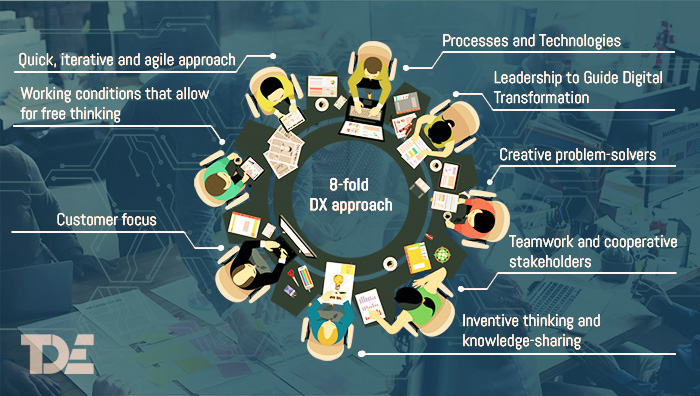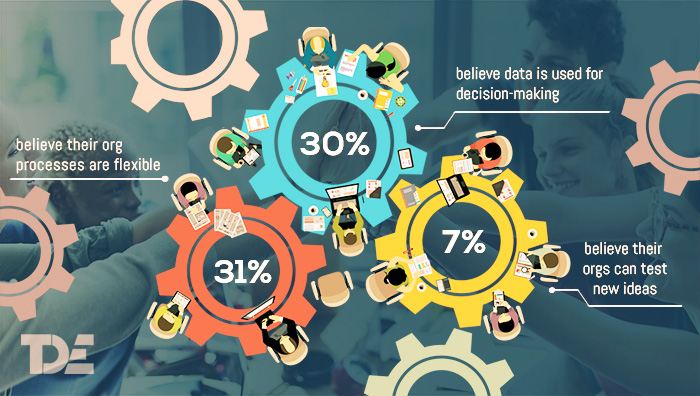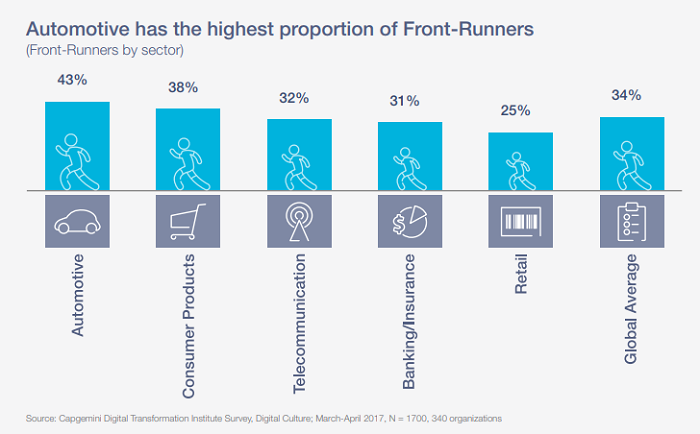Org Culture – The Cog That Can Set Digital Transformation in Motion

As today’s enterprises embark upon a journey of digital transformation, it’s the existing ecosystems and organizational cultures in practice that will primarily impact how smooth and seamless the transition for all the stakeholders is, be it management, employees or customers.
Digitalization of the workspace is no longer a far-off distant utopian vision to pursue. It’s happening in the here and now, and timely organizational reforms are critical to the success and the timeliness of the transformation.
According to a Capgemini report, four out of 10 Fortune 500 companies are at risk of disappearing from the market by 2025 due to lack of organizational adaptability to digitalization. When put in business perspective, that figure is alarming, especially when one takes into account that these are Fortune 500 companies. It goes on to highlight how most organizations are still some way adrift of completely imbibing a culture of digital transformation across the board.
In a fast-evolving ecosystem, digitalization of enterprises is not merely an objective – it is an ongoing endeavor. With technology becoming ubiquitous in every facet of business operations, digital transformation of organizations is an absolute need to stay relevant in a rapidly changing business landscape. Unfortunately, studies clearly point at structural inadequacies within organizations as a major stumbling block for a swift and seamless transformation.
Digital #transformation is sweeping the business landscape, but you can’t become a #digital organization without a digital culture.https://t.co/BziZ0ufJbg pic.twitter.com/yw9BQVWWVu
— BostonConsultingGrp (@BCG) May 4, 2018
Much of this structural gap can be attributed to the thought processes within enterprises that could have failed to project the pace at which digitalization would proliferate businesses. As a result, most companies are now finding themselves racing against the clock to develop ‘future-ready’ capabilities. One school of thought believes that new-age, start-up companies are technically and culturally more efficient in taking to digitalization. So, what about the legacy organizations then? They can’t be expected to perish overnight. Adaptability is the key to sustenance in order to avoid vanishing from the business landscape like dinosaurs once did from this earth.
Reforms for Structural Integration
A revolution doesn’t bear fruit overnight, but the conviction in this change for the better is what ensures its sustainability. The organizational design has to be aligned to digital percolation in order to achieve enterprise goals. Now, there are various organizational models to choose from, but a model that works for one organization may not (in most case, will certainly not) work for another. It is therefore, paramount to a company’s future to strategize meticulously and chart a path that ensures that the transformation doesn’t end up hurting the company in the long run. Short-term challenges are near certainties, but it’s a small price an organization must be ready to bear in order to create a failsafe organizational structure that thrives on integration and collaboration.
 Assessing an organization’s culture on the 8 parameters can help know its digital viability and create a roadmap for continuous improvement
Assessing an organization’s culture on the 8 parameters can help know its digital viability and create a roadmap for continuous improvement
Most experts believe that the best way to asses an organization’s digital viability and culture is by following an eight-fold approach. This approach involves an in-depth understanding and study of the below cultural components that drive digital dynamism of an organization:
- Processes and Technologies
- Leadership to Guide Digital Transformation
- Creative problem-solvers
- Teamwork and cooperative stakeholders
- Inventive thinking and knowledge-sharing
- Quick, iterative and agile approach
- Working conditions that allow for free thinking
- Customer focus
This digital culture assessment allows the leadership to identify the areas that the organization is well-equipped and mature in, and recognize the dimensions that require attention and improvement in the quest for digital transformation. Insights from analyzing these parameters and the gaps or successes on them can help draw up a project plan for cultural transformation. Focusing on the weak areas from the above and bring them to the desired benchmark of company culture can prove beneficial in bringing about sustainable transformation that imbibes a digitally savvy culture for the enterprise.
Leveraging Data with Agility
 Data-driven decision-making is still at an elementary level in most organizations, with only 30% respondents believe that their organizations are making use of data analytics for decisions
Data-driven decision-making is still at an elementary level in most organizations, with only 30% respondents believe that their organizations are making use of data analytics for decisions
Big data and analytics have emerged as key determinants of how efficiently an organization transforms its digital culture. As data grows in importance and drives decision-making, successfully analyzing the quantum of data at an organization’s disposal is the key to its cultural transformation. Capgemini’s Digital Culture Report 2017 clearly proves that while organizations across industries and geographies are waking up to the potential of digital transformation, the data-driven culture is still at a rudimentary stage. Some of the critical findings of the report are:
- Only 31% of the respondents believe that their processes are flexible and adaptable
- While customer-centricity and collaboration getting the greatest emphasis, data-driven decision-making and innovations are dimensions that demand least focus
- Only 30% of the respondents believe that their organizations are making use of data and analytics for decision-making
- Only 7% of the respondents feel that their organizations have the capability of testing new ideas, learning, and deploying at pace and scale
What sets Big Data apart from other technologies is its capacity of providing an organization a holistic visibility of its customers’ choices, preferences, purchasing habits, etc. Focus on enhancing customer experience will require optimization of data with analytics helping in strategy development.
Interestingly, the industry verticals at the forefront of digital transformation are the automotive and the consumer products, who have been pushed into imbibing a culture of adaptability to keep pace with their every-changing consumer preferences. See below the percentage of companies within various sectors that are driving digital transformation.
 A Capgemini survey shows the automotive industry having the highest percentage of front-runners taking up digital transformation
A Capgemini survey shows the automotive industry having the highest percentage of front-runners taking up digital transformation
It is also worth noting that business leaders are showing a sense of urgency in embracing agile methods in their transformational journeys. Agile transformation is gradually replacing the traditional business models as the focus on customer-centricity is growing. Agile transformation is making best use of talent at disposal and encouraging collaborative work. It also indoctrinates the purpose of pilot projects and getting client feedback in the process of developing the final product. As this renders the legacy models redundant, organizations are ready to scale in quick time.
To sum, deploying technology can only achieve the desired ROI when a culture of digital transformation is imbibed within an enterprise, and understanding the gaps in bringing about this change in a company’s work ethos can be the first step in this direction. Further on, success can be accelerated by using data to know what has worked and what has not. Every employee in an organization is a change agent in themselves, and a culture of innovation and learning is all that is needed to help them grow their best digital potential.


 By
By 








